Facile Solution Process of VO2 Film with Mesh Morphology for Enhanced Thermochromic Performance
Abstract
:1. Introduction
2. Experiment and Characterization
2.1. VO2 Film Preparation with Magnetron Sputtering
2.2. Post-Synthetic Solution Processing of VO2 Films
2.3. Characterization
3. Results and Discussion
3.1. Structure and Thermochromic Performance of Solution-Processed VO2-Based Film
3.2. The Effect of Zinc Concentration on Structure and Thermochromic Performance
4. Conclusions
Author Contributions
Funding
Acknowledgments
Conflicts of Interest
References
- Kamalisarvestani, M.; Saidur, R.; Mekhilef, S.; Javadi, F. Performance, materials and coating technologies of thermochromic thin films on smart windows. Renew. Sustain. Energy Rev. 2013, 26, 353–364. [Google Scholar] [CrossRef]
- Granqvist, C.G. Transparent conductors as solar energy materials: A panoramic review. Sol. Energy Mater. Sol. Cells 2007, 91, 1529–1598. [Google Scholar]
- Kanu, S.S.; Binions, R. Thin films for solar control applications. Proc. R. Soc. A Math. Phys. Eng. Sci. 2009, 466, 19–44. [Google Scholar] [CrossRef] [Green Version]
- Li, C.; O’Halloran, K.P.; Ma, H.; Shi, S. Multifunctional multilayer films containing polyoxomctalatcs and bismuch oxide nanoparticles. J. Phys. Chem. B 2009, 113, 8043–8048. [Google Scholar] [CrossRef]
- Baetens, R.; Jelle, B.P.; Gustavsen, A. Properties, requirements and possibilities of smart windows for dynamic daylight and solar energy control in buildings: A state-of-the-art review. Sol. Energy Mater. Sol. Cells 2010, 94, 87–105. [Google Scholar] [CrossRef] [Green Version]
- Granqvist, C.G. Electrochromic materials: Out of a niche. Nat. Mater. 2006, 5, 89–90. [Google Scholar] [CrossRef] [PubMed]
- Glaster, H.J. History of the development and industrial production of low thermal emissity coatings for high heat insulating glass units. Appl. Opt. 2008, 47, 193–199. [Google Scholar] [CrossRef]
- Chen, S.; Ma, H.; Yi, X.; Xiong, T.; Wang, H.; Ke, C. Smart VO2 thin film for protection of sensitive infrared detectors from strong laser radiation. Sens. Actuators A Phys. 2004, 115, 28–31. [Google Scholar] [CrossRef]
- Smith, A.W. Optical storage in VO2 films. Appl. Phys. Lett. 1973, 23, 437–438. [Google Scholar] [CrossRef]
- Case, F.C. Improved VO2 thin films for infrared switching. Appl. Opt. 1991, 30, 4119–4123. [Google Scholar] [CrossRef]
- Bock, D.C.; Marschilok, A.C.; Takeuchi, K.J.; Takeuchi, E.S. Batteries used to power implantable biomedical devices. Electrochimica Acta 2012, 84, 155–164. [Google Scholar] [CrossRef] [Green Version]
- Morin, F.J. Oxides Which Show a Metal-to-Insulator Transition at the Neel Temperature. Phys. Rev. Lett. 1959, 3, 34–36. [Google Scholar] [CrossRef]
- Warwick, M.E.A.; Binions, R. Advances in thermochromic vanadium dioxide films. J. Mater. Chem. A 2013, 2, 3275–3292. [Google Scholar] [CrossRef]
- Wu, C.; Feng, F.; Xie, Y. Design of vanadium oxide structures with controllable electrical properties for energy applications. Chem. Soc. Rev. 2013, 42, 5157–5183. [Google Scholar] [CrossRef] [PubMed]
- Liu, M.; Su, B.; Kaneti, Y.V.; Chen, Z.; Tang, Y.; Yuan, Y.; Gao, Y.; Jiang, L.; Jiang, X.; Yu, A. Dual-Phase Transformation: Spontaneous Self-Template Surface-Patterning Strategy for Ultra-transparent VO2 Solar Modulating Coatings. ACS Nano 2016, 11, 407–415. [Google Scholar] [CrossRef] [PubMed]
- NNing, W.; Yizhong, H.; Magdassi, S.; Mandler, D.; Hai, L.; Yi, L. Formation of VO2 zero-dimensional/nanoporous layers with large supercooling effects and enhanced thermochromic properties. RSC Adv. 2013, 3, 7124. [Google Scholar] [CrossRef]
- Kang, L.; Gao, Y.; Luo, H.; Chen, Z.; Du, J.; Zhang, Z. Nanoporous thermochromic VO2 films with low optical constants, enhanced luminous transmittance and thermochromic properties. ACS Appl. Mater. Inter. 2011, 3, 135–138. [Google Scholar] [CrossRef] [PubMed]
- Zhou, M.; Bao, J.; Tao, M.; Zhu, R.; Lin, Y.; Zhang, X.; Xie, Y. Periodic porous thermochromic VO2(M) films with enhanced visible transmittance. Chem. Commun. 2013, 49, 6021–6023. [Google Scholar] [CrossRef]
- Sun, G.; Cao, X.; Li, X.; Bao, S.; Li, N.; Liang, M.; Gloter, A.; Gu, H.; Jin, P. Low-temperature deposition of VO2 films with high crystalline degree by embedding multilayered structure. Sol. Energy Mater. Sol. Cells 2016, 161, 70–76. [Google Scholar] [CrossRef]
- Miller, M.J.; Wang, J.L. Multilayer ITO/VO2/TiO2 thin films for control of solar and thermal spectra. Sol. Energy Mater. Sol. Cells 2016, 154, 88–93. [Google Scholar] [CrossRef]
- Liu, H.; Wan, D.; Ishaq, A.; Chen, L.; Guo, B.; Shi, S.; Luo, H.; Gao, Y. Sputtering deposition of sandwich-structure V2O5/Metal/V2O5 multilayers for the preparation of high-performance thermally sensitive VO2 thin films with selectivity of VO2 (B) and VO2 (M) polymorph. ACS Appl. Mater. Inter. 2016, 8, 7884–7890. [Google Scholar] [CrossRef]
- Kang, J.; Liu, J.; Shi, F.; Dong, Y.; Song, X.; Wang, Z.; Tian, Z.; Xu, J.; Ma, J.; Zhao, X. Facile fabrication of VO2/SiO2 aerogel composite films with excellent thermochromic properties for smart windows. Appl. Surf. Sci. 2022, 573, 151507. [Google Scholar] [CrossRef]
- Long, S.; Cao, X.; Li, N.; Xin, Y.; Sun, G.; Chang, T.; Bao, S.; Jin, P. Application-oriented VO2 thermochromic coatings with composite structures: Optimized optical performance and robust fatigue properties. Sol. Energy Mater. Sol. Cells 2018, 189, 138–148. [Google Scholar] [CrossRef]
- Zong, H.; Zhou, D.; Yan, L.; Li, M.; Qiao, W.; Zhang, S.; Hu, Q.; Bian, L. Preparation and characterization of HfO2/VO2/HfO2 sandwich structures with low phase transition temperature, excellent thermochromic properties, and superior durability. Ceram. Int. 2022, 48, 6734–6744. [Google Scholar] [CrossRef]
- Fang, Z.; Tian, S.; Li, B.; Liu, Q.; Liu, B.; Zhao, X.; Sankar, G. VO2/ZnO bilayer films with enhanced thermochromic property and durability for smart windows. Appl. Surf. Sci. 2021, 540, 148414. [Google Scholar] [CrossRef]
- Goodenough, J.B. The two components of the crystallographic transition in VO2. J. Solid State Chem. 1971, 3, 490–500. [Google Scholar] [CrossRef]
- Zylbersztejn, A.M.N.F.; Mott, N.F. Metal-insulator transion in vanadium dioxide. Phys. Rev. B 1975, 11, 4383. [Google Scholar] [CrossRef] [Green Version]
- Gomez-Heredia, C.L.; Ramirez-Rincon, J.A.; Bhardwaj, D.; Rajasekar, P.; Tadeo, I.J.; Cervantes-Lopez, J.L.; Ordonez-Miranda, J.; Ares, O.; Umarji, A.M.; Drevillon, J.; et al. Measurement of the hysteretic thermal properties of W-doped and undoped nanocrystalline powers of VO2. Sci Rep. 2019, 9, 14687. [Google Scholar] [CrossRef] [Green Version]
- Brown, B.L.; Lee, M.; Clem, P.G.; Nordquist, C.D.; Jordan, T.S.; Wolfley, S.L.; Leonhardt, D.; Edney, C.; Custer, J.A. Electrical and optical characterization of the metal-insulator transition temperature inCr-doped VO2 thin films. J. Appl. Phys. 2013, 113, 173704. [Google Scholar] [CrossRef]
- Chen, S.; Wang, Z.; Ren, H.; Chen, Y.; Yan, W.; Wang, C.; Li, B.; Jiang, J.; Zou, C. Gate-controlled VO2 phase transition for high-performance smart windows. Sci. Adv. 2019, 5, 6815. [Google Scholar] [CrossRef] [Green Version]
- Chen, H.W.; Li, C.I.; Ma, C.H.; Chu, Y.H.; Liu, H.L. Strain engineering of optical properties in transparent VO2/muscovite heterstructures. Phys. Chem. Chem. Phys. 2021, 23, 8908. [Google Scholar] [CrossRef]
- D’Elia, A.; Grazioli, C.; Cossaro, A.; Li, B.W.; Zou, C.W.; Rezvani, S.J.; Pinto, N.; Marcelli, A.; Coreno, M. Strain mediated filling control nature of the metal-insulator transition of VO2 and electron correlation effects in nannostructured films. Appl. Surf. Sci. 2021, 540, 148341. [Google Scholar] [CrossRef]
- Nazari, M.; Zhao, Y.; Kuryatkov, V.V.; Fan, Z.Y.; Bernussi, A.A.; Holtz, M. Temperature dependence of the optical properties of VO2 deposited on sapphire with different orientations. Phys. Rev. B 2013, 87, 035142. [Google Scholar] [CrossRef] [Green Version]
- Chen, Y.; Shao, Z.; Yang, Y.; Zhao, S.; Tao, Y.; Yao, H.; Luo, H.; Cao, X.; Jin, P. Electrons-donating derived dual-resistant curst of VO2 nano-particles via ascorbic acid treament for highly stable smart windows appplications. ACS Appl. Mater. Inter. 2019, 11, 41229–41237. [Google Scholar] [CrossRef]
- Long, S.; Cao, X.; Wang, Y.; Chang, T.; Li, N.; Jin, L.; Ma, L.; Xu, F.; Sun, G.; Jin, P. Karst landform-like VO2 single layer solution: Controllable morphology and excellent optical performance for smart glazing applications. Sol. Energy Mater. Sol. Cells 2020, 209, 110449. [Google Scholar] [CrossRef]
- Ji, H.; Liu, D.; Zhang, C.; Cheng, H. VO2/ZnS core-shell nanoparticle for the adaptive infrared camouflage application with modified color and enhanced oxidation resistance. Sol. Energy Mater. Sol. Cells 2018, 176, 1–8. [Google Scholar] [CrossRef]
- Wang, Z.; Li, B.; Tian, S.; Liu, B.; Zhao, X.; Zhou, X.; Tang, G.; Pang, A. Acid Solution Processed VO2-Based Composite Films with Enhanced Thermochromic Properties for Smart Windows. Materials 2021, 14, 4927. [Google Scholar] [CrossRef] [PubMed]
- Liang, M.-K.; Limo, M.J.; Rabada, A.S.; Roe, M.J.; Perry, C.C. New Insights into the Mechanism of ZnO Formation from Aqueous Solutions of Zinc Acetate and Zinc Nitrate. Chem. Mater. 2014, 26, 4119–4129. [Google Scholar] [CrossRef]
- Mar, L.G.; Timbrell, P.Y.; Lamb, R.N. An XPS study of zinc oxide thin film growth on copper using zinc acetate as a precursor. Thin Solid Films 1993, 223, 341–347. [Google Scholar]
- Wagner, C.D.; Riggs, W.M.; Davis, L.E.; Moulder, J.F.; Muilenberg, G.E. Handbook of X-ray Photoelectron Spectroscopy; Perkin-Elmer Corporation (Physical Electronics): Eden Prairie, MN, USA, 1979. [Google Scholar]
- Onyiriuka, E. Zinc phosphate glass surfaces studied by XPS. J. Non-Crystalline Solids 1993, 163, 268–273. [Google Scholar] [CrossRef]
- Augustynski, J.; Koudelka, M.; Sanchez, J.; Conway, B.E. ESCA study of the state of iridium and oxygen in electrochemically and thermally formed iridium oxide films. Electroanal. Chem. 1984, 160, 233–248. [Google Scholar] [CrossRef]
- Clark, D.T.; Feast, W.J.; Tweedale, P.J.; Thomas, H.R. ESCA applied to polymers. XXVI. Investigation of a series of aliphatic, aromatic, and fluorine-containing polycarbonates. J. Polym. Sci. Polym. Chem. Ed. 1980, 18, 1651–1664. [Google Scholar] [CrossRef]
- Chen, J.J.; Jiang, Z.C.; Zhou, Y.; Chakraborty, B.R.; Winograd, N. Spectroscopic studies of methanol deposition on Pd[lcd]111[rcub]. Surf. Sci. 1995, 328, 248–262. [Google Scholar] [CrossRef]
- Clark, D.T.; Kilcast, D.; Musgrave, W.K.R. Molecular core binding energies for some monosubstituted benzenes, as determined by X-ray photoelectron spectroscopy. J. Chem. Soc. D 1971, 10, 516b–518. [Google Scholar] [CrossRef]
- Sang, J.; Zhu, W.; Feng, Y.; Liu, Y.; Shang, J.; Sun, J.; Guo, L.; Zhang, Y.; Zhao, S.; Chigrinov, V.; et al. Smart Windows with a VO2 Thin Film as a Conductive Layer for Efficient and Independent Dual-Band Modulation. ACS Appl. Electron. Mater. 2021, 3, 4882–4890. [Google Scholar] [CrossRef]


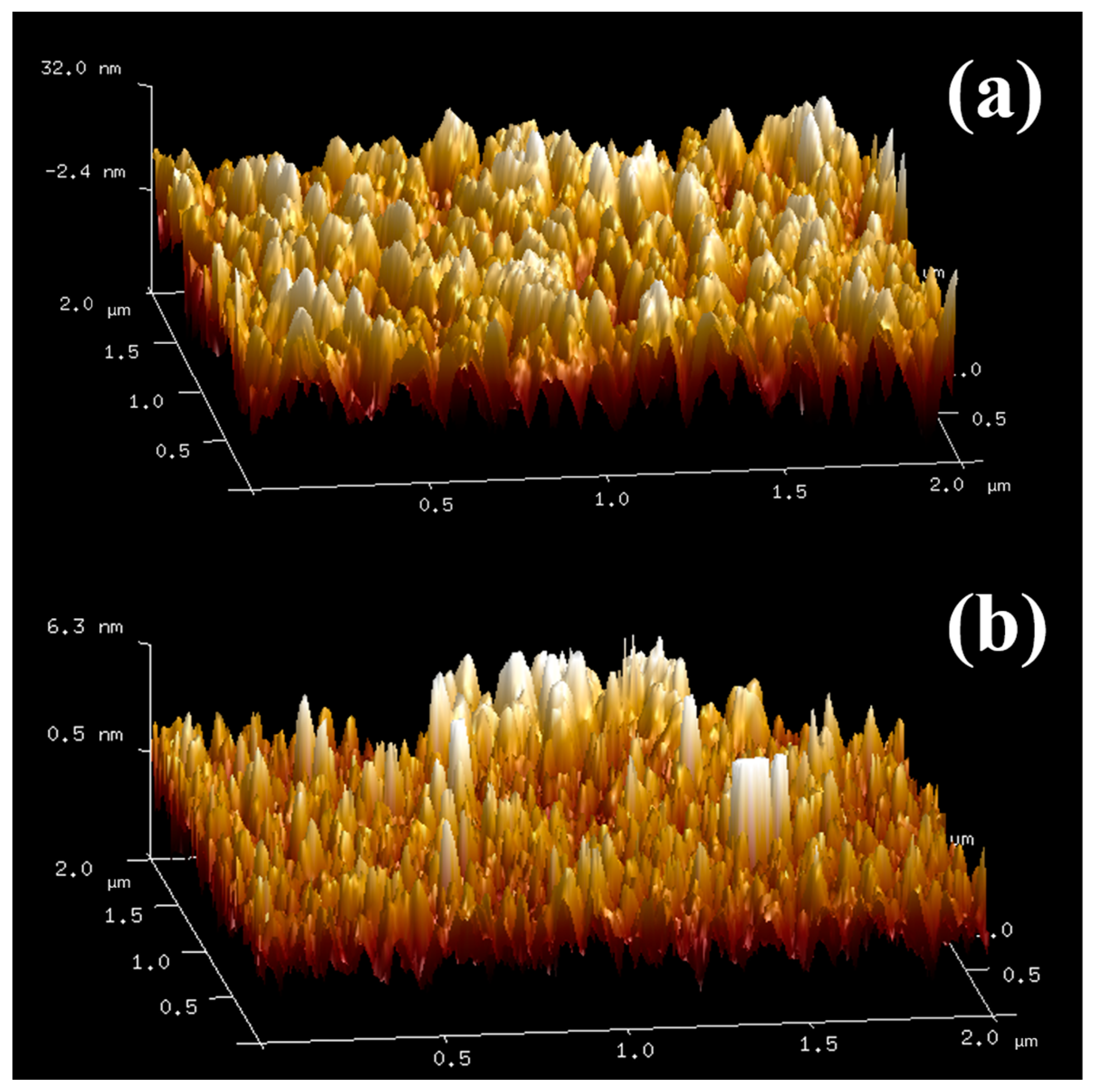
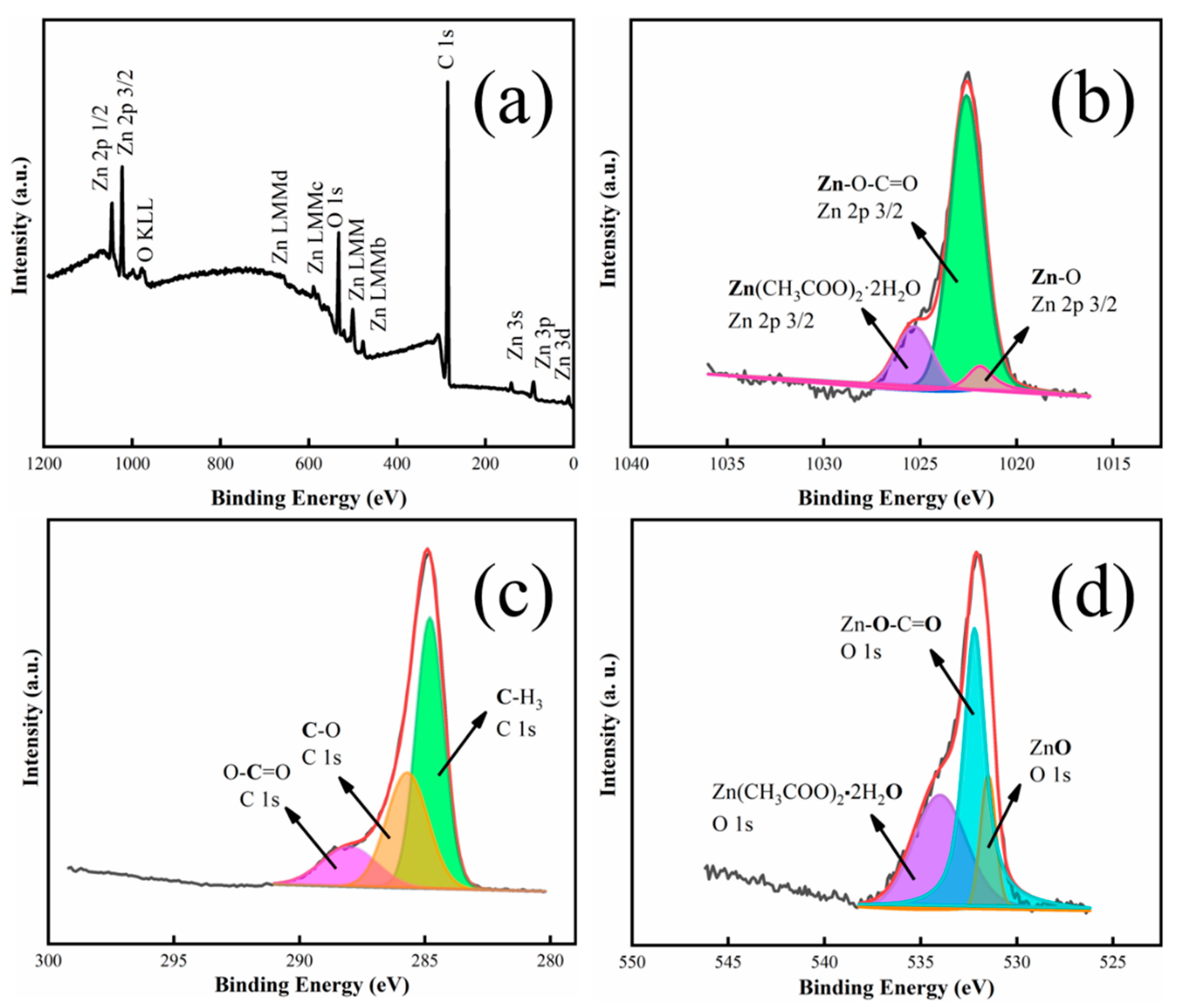
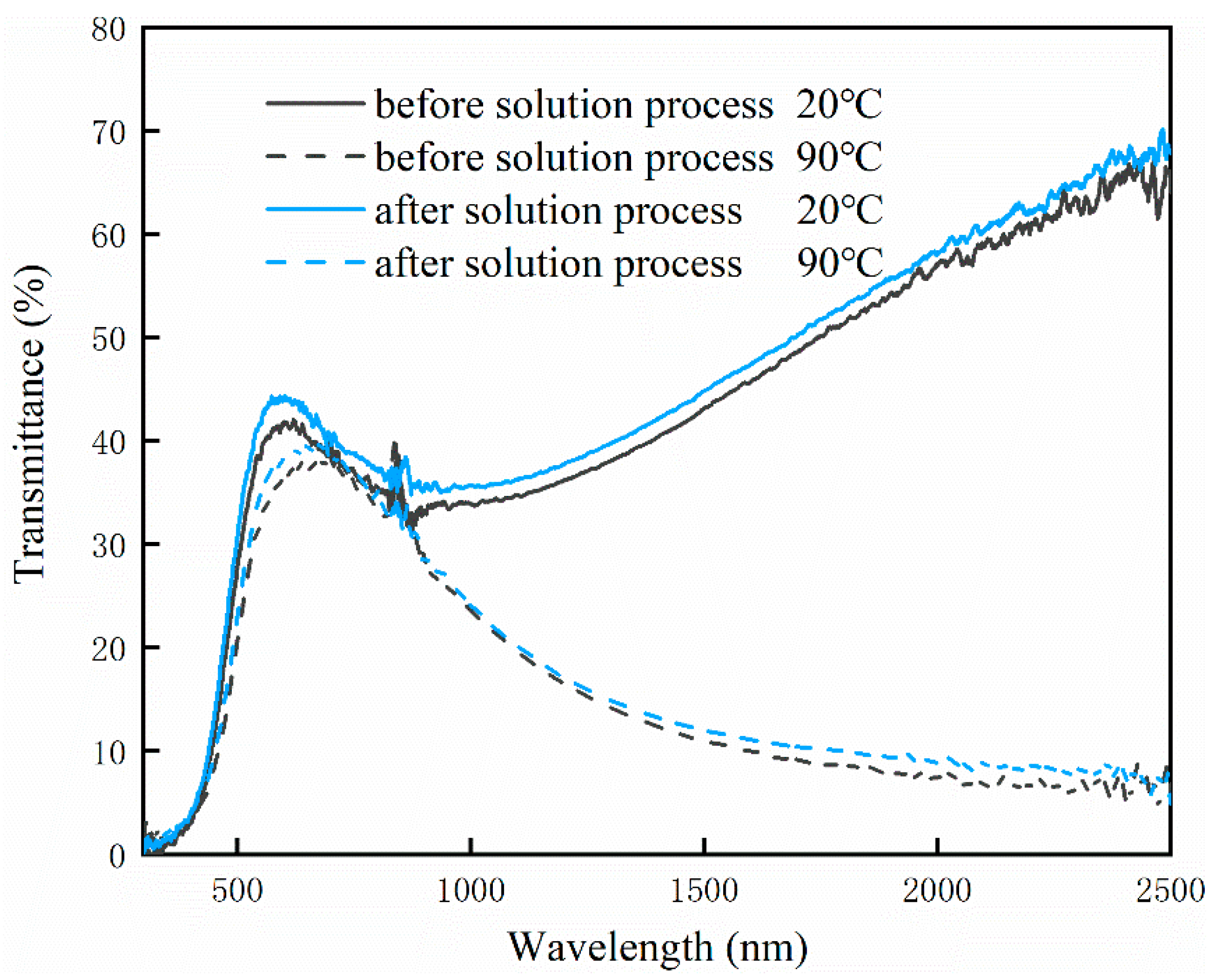
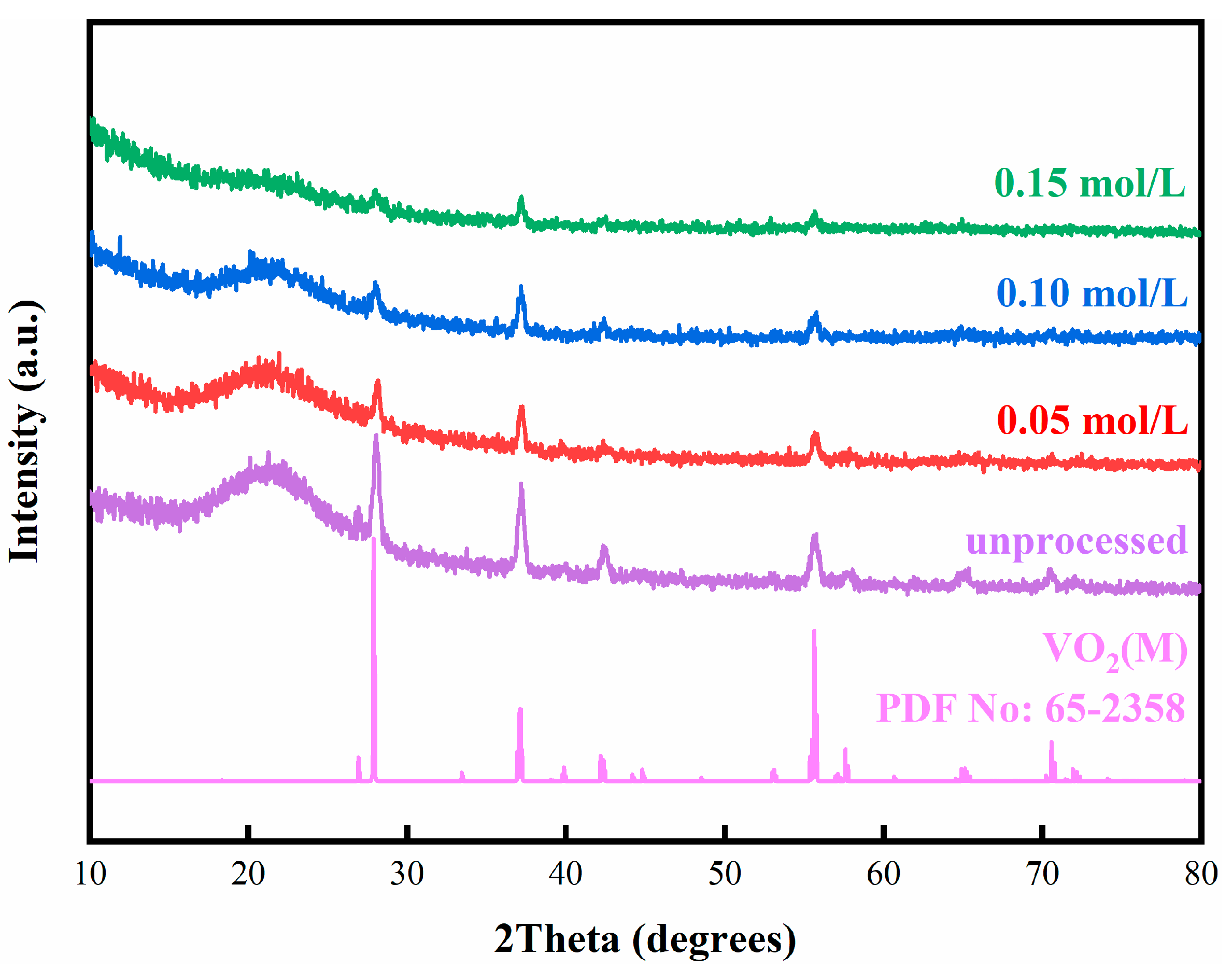
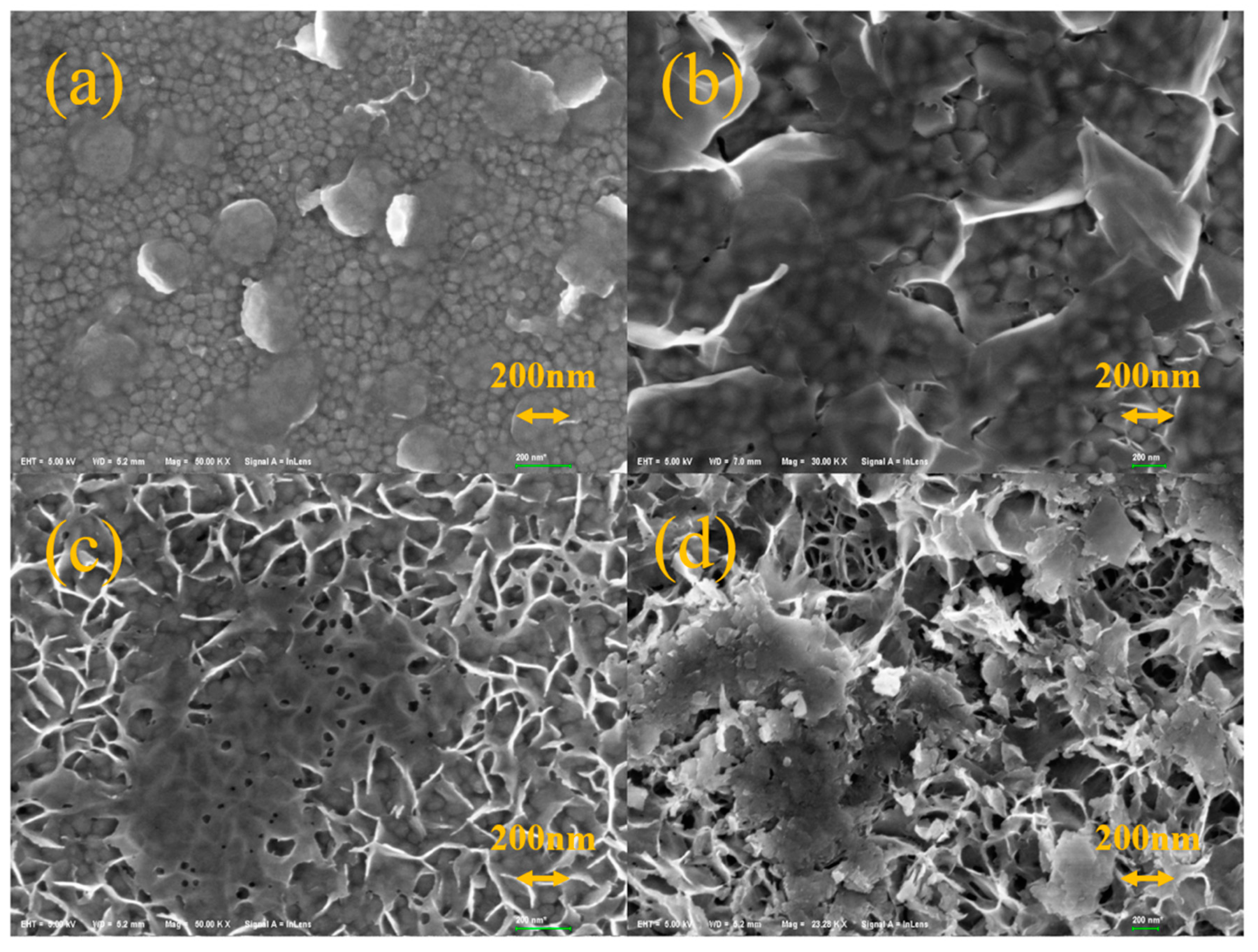
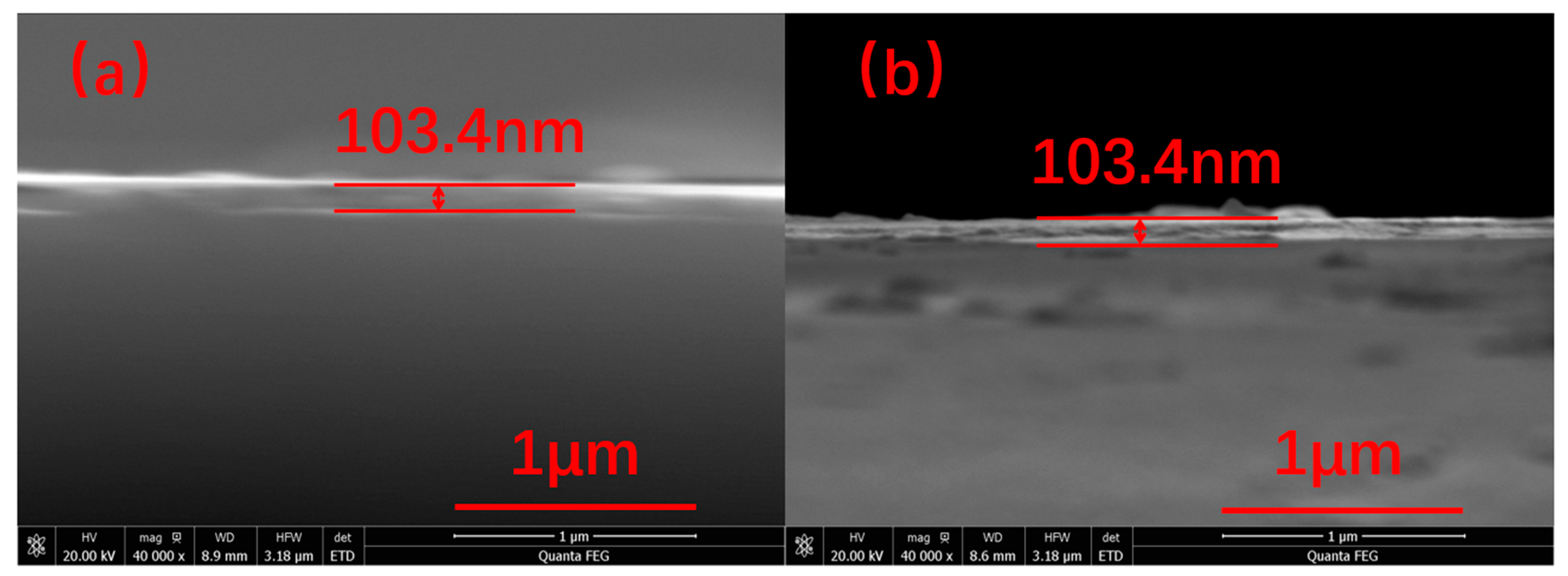
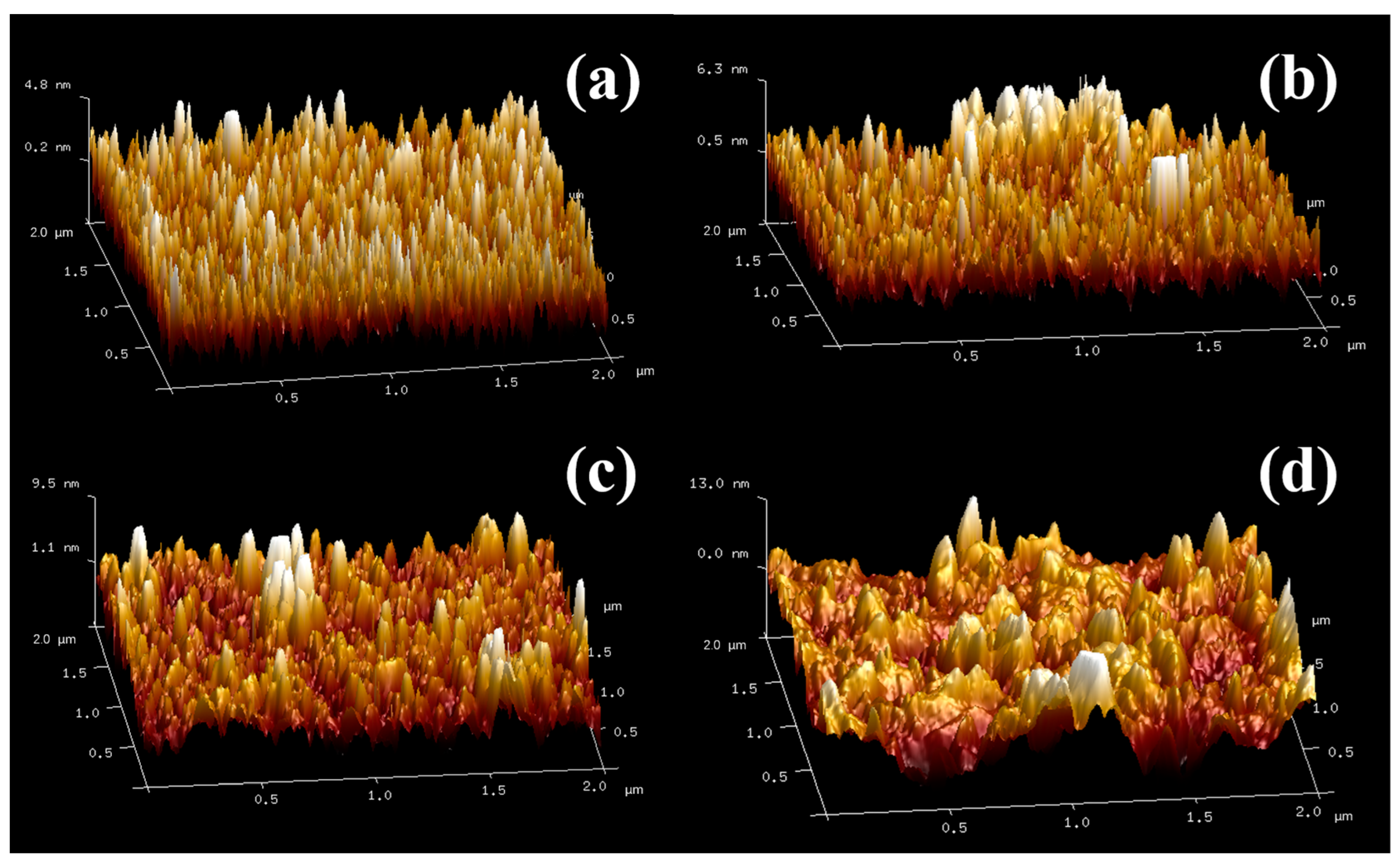


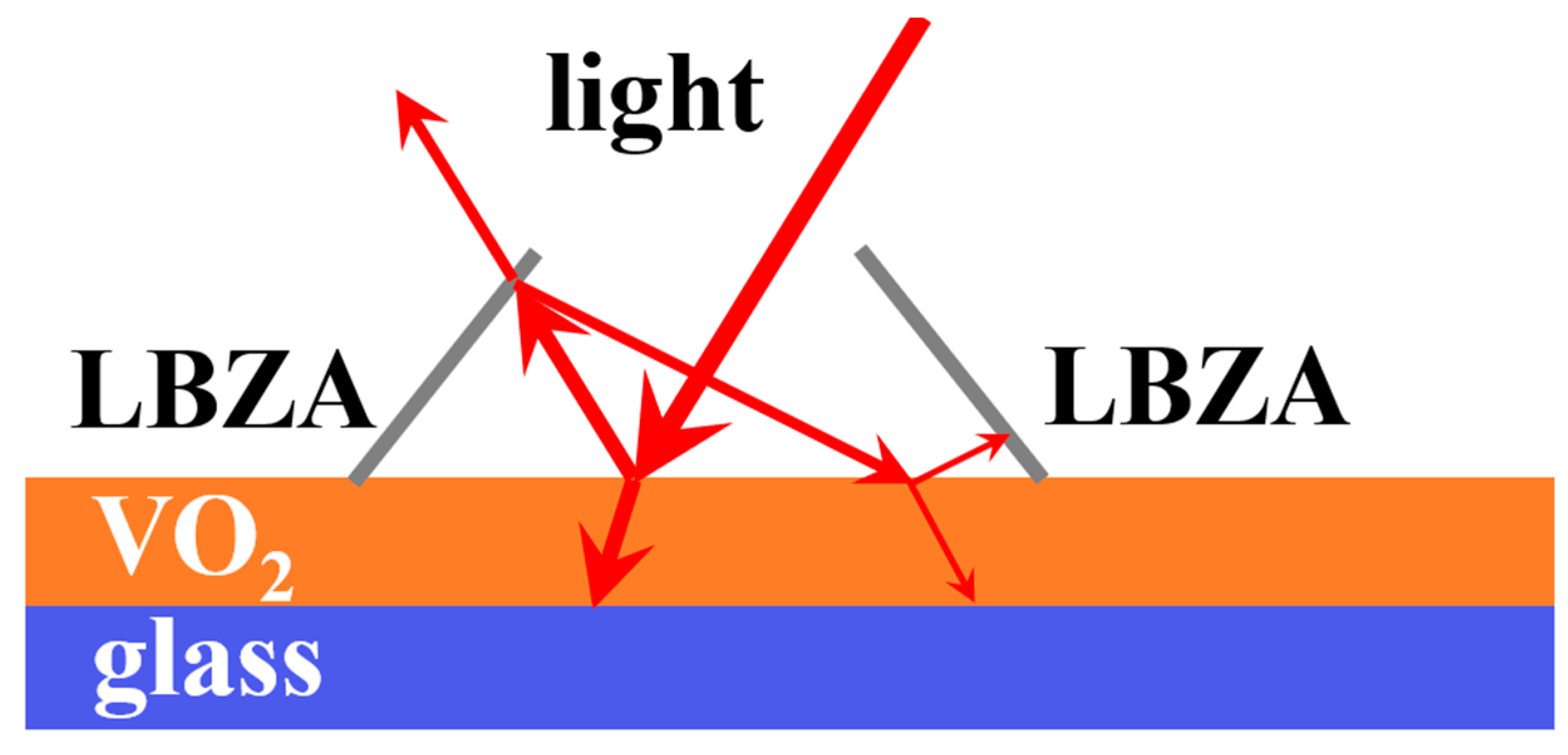
| Sample | Zinc Concentration (mol/L) | Tlum (20 °C) | Tlum (90 °C) | ∆Tsol | ∆TNIR |
|---|---|---|---|---|---|
| a | - | 37.3% | 31.2% | 9.5% | 17.4% |
| b | 0.05 | 36.2% | 30.6% | 9.8% | 18.4% |
| c | 0.10 | 40.1% | 33.5% | 10.4% | 18.8% |
| d | 0.15 | 38.2% | 32.1% | 11.3% | 20.3% |
| e | 0.20 | 35.5% | 30.1% | 11.3% | 20.5% |
| Samples | Thermochromic Properties | References | |
|---|---|---|---|
| Tlum (%) | ∆Tsol (%) | ||
| VO2 with honeycomb structure | 95.4% | 5.5% | Liu et al. [15] |
| VO2 with nanoporous structure | 33.1% | 2.2% | Wang et al. [16] |
| VO2 with nanoporous structure | 43.4% | 14.1% | Kang et al. [17] |
| VO2 with periodic porous | 67.5% | 7.5% | Zhou et al. [18] |
| AZO/PDLC/VO2 | 39.9% | 9.95% | Sang et al. [46] |
| LBZA/VO2 | 40.1% | 10.4% | This work (sample c) |
| LBZA/VO2 | 38.2% | 11.3% | This work (sample d) |
Publisher’s Note: MDPI stays neutral with regard to jurisdictional claims in published maps and institutional affiliations. |
© 2022 by the authors. Licensee MDPI, Basel, Switzerland. This article is an open access article distributed under the terms and conditions of the Creative Commons Attribution (CC BY) license (https://creativecommons.org/licenses/by/4.0/).
Share and Cite
Yu, Z.; Wang, Z.; Li, B.; Tian, S.; Tang, G.; Pang, A.; Zeng, D.; Sankar, G. Facile Solution Process of VO2 Film with Mesh Morphology for Enhanced Thermochromic Performance. Materials 2022, 15, 4129. https://doi.org/10.3390/ma15124129
Yu Z, Wang Z, Li B, Tian S, Tang G, Pang A, Zeng D, Sankar G. Facile Solution Process of VO2 Film with Mesh Morphology for Enhanced Thermochromic Performance. Materials. 2022; 15(12):4129. https://doi.org/10.3390/ma15124129
Chicago/Turabian StyleYu, Zhao, Zhe Wang, Bin Li, Shouqin Tian, Gen Tang, Aimin Pang, Dawen Zeng, and Gopinathan Sankar. 2022. "Facile Solution Process of VO2 Film with Mesh Morphology for Enhanced Thermochromic Performance" Materials 15, no. 12: 4129. https://doi.org/10.3390/ma15124129
APA StyleYu, Z., Wang, Z., Li, B., Tian, S., Tang, G., Pang, A., Zeng, D., & Sankar, G. (2022). Facile Solution Process of VO2 Film with Mesh Morphology for Enhanced Thermochromic Performance. Materials, 15(12), 4129. https://doi.org/10.3390/ma15124129







